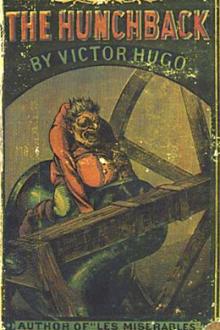Notre-Dame de Paris, Victor Hugo [reading the story of the .txt] 📗

- Author: Victor Hugo
- Performer: -
Book online «Notre-Dame de Paris, Victor Hugo [reading the story of the .txt] 📗». Author Victor Hugo
The ground of the University was hilly; Mount Sainte- Geneviève formed an enormous mound to the south; and it was a sight to see from the summit of Notre-Dame how that throng of narrow and tortuous streets (to-day the Latin Quarter), those bunches of houses which, spread out in every direction from the top of this eminence, precipitated themselves in disorder, and almost perpendicularly down its flanks, nearly to the water’s edge, having the air, some of falling, others of clambering up again, and all of holding to one another. A continual flux of a thousand black points which passed each other on the pavements made everything move before the eyes; it was the populace seen thus from aloft and afar.
Lastly, in the intervals of these roofs, of these spires, of these accidents of numberless edifices, which bent and writhed, and jagged in so eccentric a manner the extreme line of the University, one caught a glimpse, here and there, of a great expanse of moss-grown wall, a thick, round tower, a crenellated city gate, shadowing forth the fortress; it was the wall of Philip Augustus. Beyond, the fields gleamed green; beyond, fled the roads, along which were scattered a few more suburban houses, which became more infrequent as they became more distant. Some of these faubourgs were important: there were, first, starting from la Tournelle, the Bourg Saint-Victor, with its one arch bridge over the Bièvre, its abbey where one could read the epitaph of Louis le Gros, epitaphium Ludovici Grossi, and its church with an octagonal spire, flanked with four little bell towers of the eleventh century (a similar one can be seen at Etampes; it is not yet destroyed); next, the Bourg Saint- Marceau, which already had three churches and one convent; then, leaving the mill of the Gobelins and its four white walls on the left, there was the Faubourg Saint-Jacques with the beautiful carved cross in its square; the church of Saint- Jacques du Haut-Pas, which was then Gothic, pointed, charming; Saint-Magloire, a fine nave of the fourteenth century, which Napoleon turned into a hayloft; Notre-Dame des Champs, where there were Byzantine mosaics; lastly, after having left behind, full in the country, the Monastery des Chartreux, a rich edifice contemporary with the Palais de Justice, with its little garden divided into compartments, and the haunted ruins of Vauvert, the eye fell, to the west, upon the three Roman spires of Saint-Germain des Prés. The Bourg Saint-Germain, already a large community, formed fifteen or twenty streets in the rear; the pointed bell tower of Saint- Sulpice marked one corner of the town. Close beside it one descried the quadrilateral enclosure of the fair of Saint- Germain, where the market is situated to-day; then the abbot’s pillory, a pretty little round tower, well capped with a leaden cone; the brickyard was further on, and the Rue du Four, which led to the common bakehouse, and the mill on its hillock, and the lazar house, a tiny house, isolated and half seen.
But that which attracted the eye most of all, and fixed it for a long time on that point, was the abbey itself. It is certain that this monastery, which had a grand air, both as a church and as a seignory; that abbatial palace, where the bishops of Paris counted themselves happy if they could pass the night; that refectory, upon which the architect had bestowed the air, the beauty, and the rose window of a cathedral; that elegant chapel of the Virgin; that monumental dormitory; those vast gardens; that portcullis; that drawbridge; that envelope of battlements which notched to the eye the verdure of the surrounding meadows; those courtyards, where gleamed men at arms, intermingled with golden copes;—the whole grouped and clustered about three lofty spires, with round arches, well planted upon a Gothic apse, made a magnificent figure against the horizon.
When, at length, after having contemplated the University for a long time, you turned towards the right bank, towards the Town, the character of the spectacle was abruptly altered. The Town, in fact much larger than the University, was also less of a unit. At the first glance, one saw that it was divided into many masses, singularly distinct. First, to the eastward, in that part of the town which still takes its name from the marsh where Camulogènes entangled Caesar, was a pile of palaces. The block extended to the very water’s edge. Four almost contiguous Hôtels, Jouy, Sens, Barbeau, the house of the Queen, mirrored their slate peaks, broken with slender turrets, in the Seine.
These four edifices filled the space from the Rue des Nonaindières, to the abbey of the Celestins, whose spire gracefully relieved their line of gables and battlements. A few miserable, greenish hovels, hanging over the water in front of these sumptuous Hôtels, did not prevent one from seeing the fine angles of their façades, their large, square windows with stone mullions, their pointed porches overloaded with statues, the vivid outlines of their walls, always clear cut, and all those charming accidents of architecture, which cause Gothic art to have the air of beginning its combinations afresh with every monument.
Behind these palaces, extended in all directions, now broken, fenced in, battlemented like a citadel, now veiled by great trees like a Carthusian convent, the immense and multiform enclosure of that miraculous Hôtel de Saint-Pol, where the King of France possessed the means of lodging superbly two and twenty princes of the rank of the dauphin and the Duke of Burgundy, with their domestics and their suites, without counting the great lords, and the emperor when he came to view Paris, and the lions, who had their separate Hôtel at the royal Hôtel. Let us say here that a prince’s apartment was then composed of never less than eleven large rooms, from the chamber of state to the oratory, not to mention the galleries, baths, vapor-baths, and other “superfluous places,” with which each apartment was provided; not to mention the private gardens for each of the king’s guests; not to mention the kitchens, the cellars, the domestic offices, the general refectories of the house, the poultry-yards, where there were twenty-two general laboratories, from the bakehouses to the wine-cellars; games of a thousand sorts, malls, tennis, and riding at the ring; aviaries, fishponds, menageries, stables, barns, libraries, arsenals and foundries. This was what a king’s palace, a Louvre, a Hôtel de Saint-Pol was then. A city within a city.
From the tower where we are placed, the Hôtel Saint-Pol, almost half hidden by the four great houses of which we have just spoken, was still very considerable and very marvellous to see. One could there distinguish, very well, though cleverly united with the principal building by long galleries, decked with painted glass and slender columns, the three Hôtels which Charles V. had amalgamated with his palace: the Hôtel du Petit-Muce, with the airy balustrade, which formed a graceful border to its roof; the Hôtel of the Abbe de Saint-Maur, having the vanity of a stronghold, a great tower, machicolations, loopholes, iron gratings, and over the large Saxon door, the armorial bearings of the abbé, between the two mortises of the drawbridge; the Hôtel of the Comte d’ Etampes, whose donjon keep, ruined at its summit, was rounded and notched like a cock’s comb; here and there, three or four ancient oaks, forming a tuft together like enormous cauliflowers; gambols of swans, in the clear water of the fishponds, all in folds of light and shade; many courtyards of which one beheld picturesque bits; the Hôtel of the Lions, with its low, pointed arches on short, Saxon pillars, its iron gratings and its perpetual roar; shooting up above the whole, the scale- ornamented spire of the Ave-Maria; on the left, the house of the Provost of Paris, flanked by four small towers, delicately grooved, in the middle; at the extremity, the Hôtel Saint-Pol, properly speaking, with its multiplied façades, its successive enrichments from the time of Charles V., the hybrid excrescences, with which the fancy of the architects had loaded it during the last two centuries, with all the apses of its chapels, all the gables of its galleries, a thousand weathercocks for the four winds, and its two lofty contiguous towers, whose conical roof, surrounded by battlements at its base, looked like those pointed caps which have their edges turned up.
Continuing to mount the stories of this amphitheatre of palaces spread out afar upon the ground, after crossing a deep ravine hollowed out of the roofs in the Town, which marked the passage of the Rue Saint-Antoine, the eye reached the house of Angoulême, a vast construction of many epochs, where there were perfectly new and very white parts, which melted no better into the whole than a red patch on a blue doublet. Nevertheless, the remarkably pointed and lofty roof of the modern palace, bristling with carved eaves, covered with sheets of lead, where coiled a thousand fantastic arabesques of sparkling incrustations of gilded bronze, that roof, so curiously damascened, darted upwards gracefully from the midst of the brown ruins of the ancient edifice; whose huge and ancient towers, rounded by age like casks, sinking together with old age, and rending themselves from top to bottom, resembled great bellies unbuttoned. Behind rose the forest of spires of the Palais des Tournelles. Not a view in the world, either at Chambord or at the Alhambra, is more magic, more aerial, more enchanting, than that thicket of spires, tiny bell towers, chimneys, weather-vanes, winding staircases, lanterns through which the daylight makes its way, which seem cut out at a blow, pavilions, spindle-shaped turrets, or, as they were then called, “tournelles,” all differing in form, in height, and attitude. One would have pronounced it a gigantic stone chess-board.
To the right of the Tournelles, that truss of enormous towers, black as ink, running into each other and tied, as it were, by a circular moat; that donjon keep, much more pierced with loopholes than with windows; that drawbridge, always raised; that portcullis, always lowered,—is the Bastille. Those sorts of black beaks which project from between the battlements, and which you take from a distance to be cave spouts, are cannons.
Beneath them, at the foot of the formidable edifice, behold the Porte Sainte-Antoine, buried between its





Comments (0)